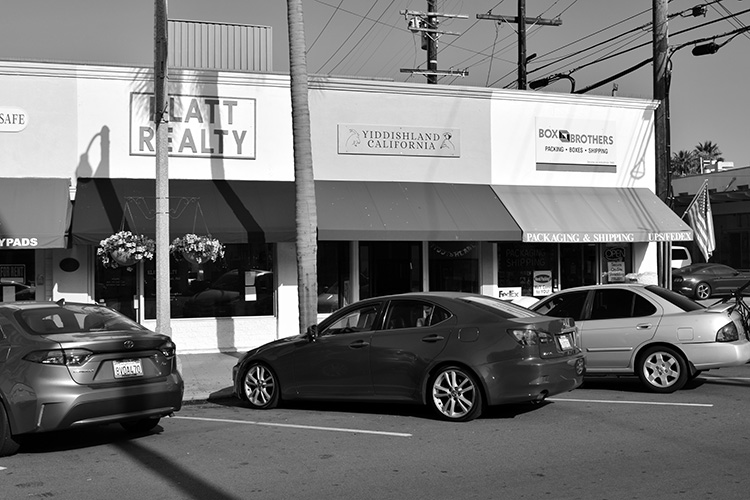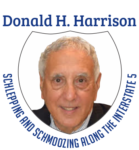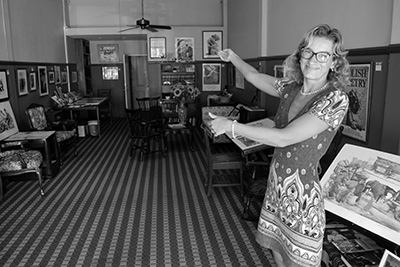 Editor’s Note: This is the ninth chapter in Volume 2 of Editor Emeritus Donald H. Harrison’s 2022 trilogy, “Schlepping and Schmoozing Along the Interstate 5.” All three books may be purchased from Amazon.com or at any of the lectures that Harrison delivers to groups around the county. Harrison may be contacted to speak to your group via donald.harrison@sdjewishworld.com
Editor’s Note: This is the ninth chapter in Volume 2 of Editor Emeritus Donald H. Harrison’s 2022 trilogy, “Schlepping and Schmoozing Along the Interstate 5.” All three books may be purchased from Amazon.com or at any of the lectures that Harrison delivers to groups around the county. Harrison may be contacted to speak to your group via donald.harrison@sdjewishworld.com
Schlepping and Schmoozing Along the Interstate 5, Exit 26 A (La Jolla Parkway): Yiddishland
From the northbound Interstate 5, exit onto La Jolla Village Parkway and keep straight onto Torrey Pines Road. Bear right onto Ivanhoe Avenue East, then bear right onto Ivanhoe Avenue. Turn left to 1128 Wall Street, La Jolla.

 LA JOLLA, California –Before she decided to move to San Diego in 2016, Jana Mazurkiewicz had been in the United States for three years and was compiling information for a University of Michigan doctoral dissertation about the Yiddish Theatre in Warsaw under Communism. The daughter of a Jewish father and a Polish mother who converted to her father’s religion, Mazurkiewicz spoke both Yiddish and Polish as well as several other languages. She sought the company of other Yiddish speakers here and soon found them.
LA JOLLA, California –Before she decided to move to San Diego in 2016, Jana Mazurkiewicz had been in the United States for three years and was compiling information for a University of Michigan doctoral dissertation about the Yiddish Theatre in Warsaw under Communism. The daughter of a Jewish father and a Polish mother who converted to her father’s religion, Mazurkiewicz spoke both Yiddish and Polish as well as several other languages. She sought the company of other Yiddish speakers here and soon found them.
“You can go to a Jewish community and ask, ‘Is there a Yiddish speaker in town?’ and you will be surprised; they are everywhere,” she told me. “You can go to Alaska, and you will meet Yiddish speakers. You can build your travels around it.”
Whereas in some other cities like Los Angeles and New York, you can find centers where Yiddish speakers meet and schmooze on a daily basis, she found no such venue in San Diego. To assess how much interest there might be in Yiddish language and culture in San Diego, Mazurkiewicz offered a class in Yiddish at the Lawrence Family JCC, Jacobs Family Campus. With very little publicity, it attracted 50 people. “So, then we knew there were people who wanted to learn,” she said. “You don’t want to start something if people don’t come. It might not be necessary or needed.”

Mazurkiewicz continued to organize social gatherings hosted in her home and later in various community centers and, given the interest in these events, she created the non-profit organization, Yiddish Arts and Academics Association of North America (YAAANA).
Mazurkiewicz formally launched YAAANA in San Diego in April 2017 with a Shabbat dinner and a klezmer conference featuring violinist Yale Strom, his vocalist wife Elizabeth Schwartz, and their Hot Pstromi band. “Whenever we had events, they were always packed,” she recalled. “They were definitely popular.”
At another event, she had a videotaped showing of her multilingual play, Wooden Wars , or Anyone Can Be Jewish These Days at the Costa Verde Village Theatre. A premise of the play is that Polish people are obsessed with Judaism leading some to be antisemitic and others to be just the reverse, philosemitic.
One particularly memorable event was what she billed as a reenactment of a “Yiddish wedding,” her own, to Edward Meisarosh. San Diego Jewish World writer Eva Trieger reported, “this freydik gelgnhayt, joyous occasion, was replete with music, dancing, food, alcohol, storytelling, and laughter all shared by family and friends. As guests entered the hall, we were greeted by a slideshow featuring images of Polish families, homesteads and villages interspersed with pictures of Chagall paintings. The strains of Klezmer music were heard, and a full bar tempted guests with Polish vodka and rum. With bride and groom backstage, master of ceremonies and erstwhile rabbi Yale Strom, accompanied by his wife and singer Elizabeth Schwartz and bass player Jeff Pekarek, started the fabrengen. Guests were invited to join with spirited clapping. Strom narrated the event, providing explanations of tradition, ritual, and history with a richness of culture-laden stories.”
Subsequently, YAAANA offered a night of erotic Yiddish poetry, including Adam by Celia Dropkin, which begins, “Spoiled, you had been fussed over by many women’s hands when I came across you, young Adam…”
One of Mazurkiewicz Meisarosh’s favorite events was when she staged a Yiddish-style Halloween. “Halloween is pagan in origin, but you can Yiddishize anything. One of our performers that night was cast in the role of a golem. He was a big guy making scary faces. After he entered the stage, a one-year-old baby ran onto the stage and hugged his leg. Maybe the baby thought he was a bear!” she laughed.
Building on the enthusiasm that greeted these various cultural offerings, Mazurkiewicz Meisarosh in late 2021 acted upon an idea that had been incubating almost since she arrived here. She rented a 600-squae-foot storefront at 1128 Wall Street in La Jolla and named her enterprise “Yiddishland.” She intends it to be an incubator for the baby that she hopes will grow into a “mini-shtetl,” hopefully in La Jolla, with a small hotel, museum, classes, and possibly costumed docents who will introduce visitors to the resurging Yiddish world of Europe that was almost snuffed out by the Holocaust.
The small storefront on Wall Street, she said, “will give us exposure to both the locals and the tourists. If we had rented in a remote area, we would only have goats and coyotes as our visitors.”
A common misconception, which I shared, was that shtetls were somewhat like the fictional Antatevka, popularized in the stage and movie productions of Fiddler on the Roof, very loosely based on the story Tevye the Milkman. That was written by Yiddish author Sholem Aleichem, whose real name wa Solomon Naumovich Rabinovich.
“There is a big confusion about what a shtetl actually is because we don’t have shtetls in the United States, Mazurkiewicz Meisarosh informed me. “Fiddler was set in a village, which was for farming. It was, historically speaking, rather rare for Jewish people to farm. They were traditional merchants. You would have two kinds of shtetls. Architecture-wise, there were shtetls with a long street or a round marketplace full of merchants –an everyday farmers’ market.”
For the record, Mazurkiewicz Meisarosh said Tevye the Milkman was very different from Fiddler on the Roof. Sholem Aleichem “wanted to fight against the patriarchal system so Tevye was a bad guy, not this cute older Jew who loved tradition. He was basically an evil man who restrained his daughters. … The real story is so cruel, with one daughter killing herself. It was so much more graphic. When it came to the stage, everyone would cry. So, Fiddler on the Roof is a fairy tale compared to Tevye the Milkman.”
At the Yiddishland California location, there are original paintings for sale by renowned Jewish artists such as Jan Lebenstein and Seymour Rosenthal as well as books, DVDs, records and tscotchkes (knickknacks). Language classes also are offered in Yiddish, Polish, and Hebrew. “Ife we can find a Ladino teacher, that would be great,” Mazurkiewicz Meisarosh commented. “We also plan to have lectures about art, the history of Yiddish, different aspects of Yiddish culture, music, theater, entertainment and cabaret.”
In addition, the doctoral candidate who loves to host events said that Yiddishland’s programming includes “one major event a month, a variety of smaller events throughout the year, and Yiddish happy-hour sessions. During bigger events, we have the traditional, compulsory shot of vodka.”
I asked what inspired her to become such a devotee of Yiddish language and culture. “I think when I started to learn Yiddish, I found a home,” she replied. “It is such a diverse community, one of the most interesting communities I ever encountered. Yiddish speakers come from all over the world, and they bring their backgrounds.”
Yiddish, she added, “is a fusion language.” Words from other languages are absorbed because Jews have moved from one place to another. “The language grew with that. Not it is [a mixture of] Hebrew, German, some Slavic languages, even La’az (Hebrew as translated into various Romance languages).”
People who have been attracted to YAAANA and the Yiddishland storefront come from diverse places in the world, including Mexico City, New York, Moscow, and Warsaw. Others are from South Africa, including families that had immigrated to Cape Town and Johannesburg from Lithuania.
“My 4 ½ -year-old daughter speaks Yiddish too,” Mazurkiewicz Meisarosh told me late in 2021 “She loves to come to work with me. It would be great to teach Yiddish to the local Jewish kids.”
Asked how people have come to hear of YAAANA and Yiddishland, she responded, “We are big on social media. I belong to 100 Yiddish groups on Facebook alone.” She also attends numerous conferences, where she spreads the word.
“We host 50 events a year in addition to a large number of classes. Visitors can enjoy a cup of tea or coffee,” Mazurkiewicz Meisarosh said. “People are welcome to make Yiddishland their second home.”
*
Donald H. Harrison is editor emeritus of San Diego Jewish World. He may be contacted via donald.harrison@sdjewishworld.com